Introduction and Summary
The nation’s drug war is viewed as a failure by most Americans, and there is scant hope it will ever succeed. Nearly three-quarters of Americans say we are losing the drug war, and just as many say that insatiable demand will perpetuate the nation’s drug habit. Yet this deep sense of futility has not generated more momentum for alternative anti-drug strategies, like establishing more treatment programs for drug users or decriminalizing the use of some drugs. The public still gives higher priority to traditional get-tough approaches, such as interdicting drugs at the border and arresting dealers in this country, although declining numbers regard those tactics as effective.

Despite a renewed focus by the news media and entertainment industry on the nation’s drug problem, reflected in the attention drawn by the Oscar-nominated film “Traffic,” public opinion on anti-drug strategies has not changed markedly since the late 1980s. While some states have moved to roll back so-called mandatory minimum sentences for non-violent drug offenders, nearly as many people say this is a bad idea (45%) as think it is a good idea (47%). Interdiction continues to be seen as the most effective anti-drug policy, although like other such strategies, it is viewed as less fruitful than a decade ago.
But the public is more compassionate than condemnatory when it comes to the users of illegal drugs, as opposed to those who profit from the drug trade. A majority of Americans (52%) believe that drug use should be treated as a disease, compared to 35% who favor treating it as a crime.

Although drug abuse is given less priority than in the early 1990s when the Bush administration declared a “war on drugs,” it still is seen as a significant danger by most Americans — particularly African-Americans and those with lower incomes and less education. Nearly three-quarters of blacks (74%) say they are very worried about having a family member develop a drug problem, compared to just 39% of whites. And increasingly, drugs are hitting home in rural areas; people in those areas cite drugs as the top community problem.
While interdiction is regarded as the most effective anti-drug strategy, the public is divided over the current U.S. policy of providing large-scale assistance to Colombia and other drug-producing nations. Slightly over one-quarter (28%) favor cutting military aid to these nations, while a plurality (37%) is satisfied with current aid levels and 23% back increased military assistance. The public is far more opposed to providing financial aid to these countries, however.

Some black leaders have criticized mandatory minimums, but blacks and whites see eye-to-eye on this issue and several other drug policy issues. The gender gap on these issues is more significant, as both white and black women take a more punitive approach to drug sentencing questions than their male counterparts. For instance, more men than women in both races say that too many people are in jail for drug possession (53%-41%). And black women, in particular, are much more opposed to taking even modest steps toward decriminalizing marijuana than are black men or whites of either gender.
There is a consensus on one aspect of the struggle to curb drug abuse: Most blame peer pressure and bad parents for drug use among teenagers. Approximately eight-in-ten point to these factors, which fall well outside of the realm of public policy. Still, nearly three-quarters pin the blame on the ease with which teens can get drugs, which helps explain the continuing, if diminished, public support for interdiction.
Legalization of drugs remains a divisive issue — 49% favor retaining criminal penalties for possessing small amounts of marijuana, about the same as felt that way in 1985. But by better than a three-to-one margin (73%-21%), the public supports permitting doctors to prescribe marijuana for their patients.
The Pew Research Center’s survey of attitudes on illegal drugs and drug policies, conducted Feb. 14-19 among more than 1,500 adults, including an oversample of African-Americans, finds a striking contrast in long-term trends on attitudes toward crime and drugs. In the mid-1990s, Americans were just as pessimistic about crime as drugs, if not more so. In March 1994, 77% said the nation was losing ground against crime, while 62% said the same about drugs. But today, the number who are pessimistic about the struggle against crime has fallen to 38%, while far more (54%) say the nation is losing ground on drugs.
Less of a Crisis
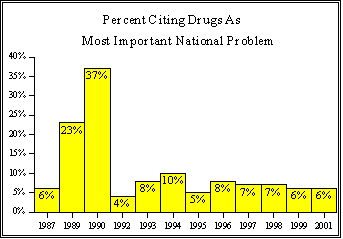
The problem of illegal drug use has receded somewhat from the national consciousness since the late 1980s and early 1990s, when there was massive media attention on the rise of crack cocaine and drug-related violence. Concern over drugs reached a peak in 1990 when 37% of the public cited it as the top national problem.
Today, morality and the quality of education top the list of most important problems facing the nation (12% and 11% respectively), while roughly six percent of Americans volunteer drugs and alcohol. That is in keeping with the trend of the past decade, when drugs have consistently been cited by between four and ten percent of Americans as the most important problem facing the nation.
Still, the public continues to rank drugs among the major problems facing both the nation and local communities, and concern about drug abuse potentially affecting a family member remains high. No less than 90% say drug abuse is a serious problem in the nation, with over a quarter calling it a national crisis. Concern is particularly evident in the African-American community; more than four-in-ten blacks (43%) rate drug abuse as a national crisis, compared to 26% of whites.
Rural Residents Worried
Drug abuse looms as a more serious problem on the local level. One-in-nine Americans (11%) list drugs and alcohol as the most important problem in their local community, placing it behind only education (14%) and crime and violence (12%).
Among rural residents, drug abuse is the leading community problem, with 16% citing it as their top concern. Drugs are the second-rated community concern among urban residents (at 13%). By comparison, the issue of drugs and alcohol doesn’t make the top tier of problems cited by suburban respondents, who are more concerned with education, crime, and growth and traffic.
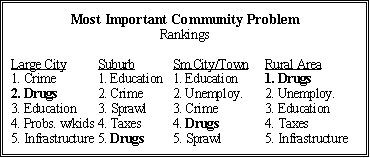
Younger people are more concerned about the drug problem at the local level than are their elders. Nearly one-in-four of those under age 30 cite drugs and alcohol as the most important problem in their area, compared to just 10% of those age 30 to 64, and 5% of those 65 and older.
The drug problem at the community level is also most immediate for those with less education and lower incomes. One-fifth of respondents with less than a high school degree rate drugs as the biggest problem in their community, while nearly as many of those in households earning less than $20,000 annually agree. By comparison, just 8% of college graduates cite drugs as their largest local concern, as do 10% of those earning $50,000 or more.
Little Progress Nationally
Not surprisingly, given the public’s harsh assessment of the drug war, more than four times as many people say the nation is losing ground on drugs (54%) as say it is making progress (13%). The only other issues that come close to eliciting this level of pessimism are the way the health care system is working (13% making progress, 53% losing ground) and education (23% making progress, 53% losing ground).

Interestingly, this bleak progress report actually represents a modest improvement from the late 1980s. In 1989 more than two-thirds thought we were losing ground on drugs, a figure which has eased down to the current 54%. But there has been no increase since then in the relatively small percentage who cites progress on drugs.
Compared to the drug problem, the public is somewhat more optimistic about avoiding racial conflict and addressing problems related to planning and managing growth around cities. And despite the downturn in the economy, many Americans remain optimistic about the availability of good-paying jobs; one-in-three feel the nation is making progress on jobs, the highest percentage in the eight years since the question was first asked.
Communities Doing Better

Views on the drug problem are a bit more optimistic at the local level, though more people believe their communities are losing ground (37%) than making progress (23%). But the public is significantly more optimistic about progress on drugs in their community than was the case in 1994, when half (51%) thought their community was losing ground on drugs, and just 16% saw progress being made.
Along the same lines, just 9% say drug abuse is a “crisis” in their neighborhood, including the local schools, compared to 27% who say this about the nation.
The concern residents of rural areas express about drugs — seen in the number who identify it as the most important problem in their community — is rooted in their sense that drug problems are getting worse and might strike closer to home. Fully 45% of rural residents feel their community is losing ground on the issue of drugs, while only 18% see it making progress. Moreover, 61% of rural residents are concerned about family members becoming involved with drugs. Residents of large cities are also concerned with drugs in their communities, but are slightly more optimistic that they are making progress on the problem.

As is the case nationally, many believe their community has made strides on the issue of crime. Roughly one-third of respondents (32%) think their local community is making progress on crime, while 23% think their community is losing ground. In 1994, just 14% said their community was gaining on crime, and 56% thought they were losing ground.
The public is also more optimistic about education at the local level than in the past, with 34% seeing local gains and 31% losses. In 1994 less than a quarter (23%) saw local gains on education, and 44% thought their community was losing ground.
Drugs Hit Home

One-in-five Americans say drug abuse has been a cause of trouble in their family and more than half are concerned about the possibility. The proportion of Americans who say drugs have caused problems in their family has gradually increased since the 1980s. In May 1985, just 9% of respondents said drugs had been a cause of trouble in their families. Today, 21% say drug use has been a problem in their family.
People in urban and suburban areas are somewhat more likely than their rural and small town counterparts to have faced drug problems in their families. Those who have tried marijuana at some point in their lives are twice as likely to have faced drug problems in their family than those who have not (32% to 15%). Not surprisingly, there is a generational component to this issue. Nearly a quarter of those under 65 have seen drugs cause problems at home, compared to just 10% of retirees.
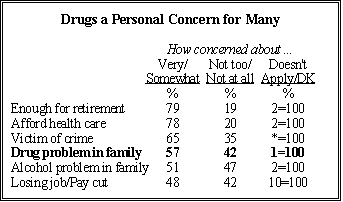
In addition to being a top national concern, drug abuse is also a significant personal worry, and concern about drugs affecting a family member has, if anything, increased since the 1980s. More than half of Americans say they are concerned about drugs causing problems in their family. Fully 44% say they are very concerned about this, compared to 36% in 1988. The possibility of a family member developing a drug problem is a concern for more Americans than is the threat of alcohol abuse.
African-Americans are far more likely to worry about the potentially negative effects of drugs on their family than are whites. Concern about drugs is also higher among the less educated, and those who have had drug problems within their family in the past. In addition, 64% of parents with teenagers are concerned about the threat of drug problems in their family, compared to 54% of those with no kids at home.
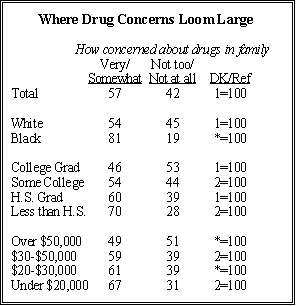
But overall, individuals are less concerned about how drugs might affect their lives than they are about their personal finances and securing adequate health care. More than three-quarters of Americans (79%) are at least somewhat concerned over saving enough for retirement. Similarly, 78% worry about affording necessary health care when a family member gets sick. Concern over retirement and health care is also greater among minority respondents, and respondents with less education and lower incomes.
Disease vs. Crime
While Americans still mostly look to law enforcement to curb illegal drug use, a slim majority says that, in general, drug abuse should be treated as a disease rather than as a crime. This may be the strongest evidence showing that Americans are open to alternative anti-drug strategies, although those strategies themselves have yet to win much support.
Perhaps not surprisingly, this issue divides Americans along political, generational and even religious lines. By a two-to-one margin (61%-30%), Democrats think of drug use as a disease rather than a crime. Republicans, on the other hand, are more likely to see drug use as a criminal behavior than a health problem (48% to 38%).
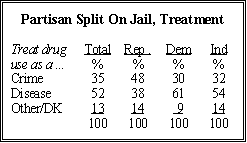
Younger people are far more liberal in their view of drug use than their elders — 58% of those under 30 say drug use is a disease, not a crime. By comparison, just 41% of seniors (age 65 and older) think of drug use as a disease.
There is also a significant religious divide on the moral implications of drug use. Evangelical Protestants are about twice as likely to think of drug use a criminal act than are mainline Protestants (48% to 25%), while nearly two-thirds of the latter (64%) say drug use is a disease.




